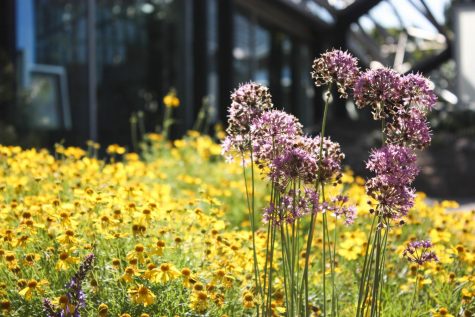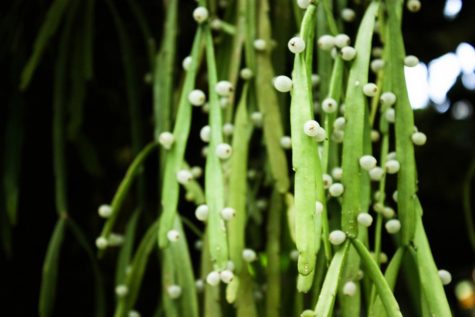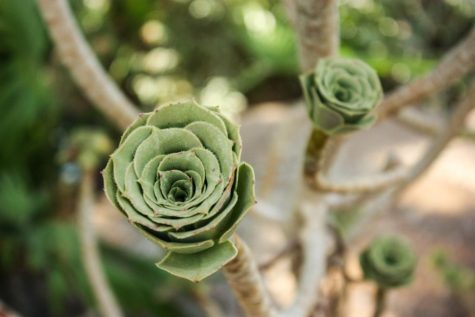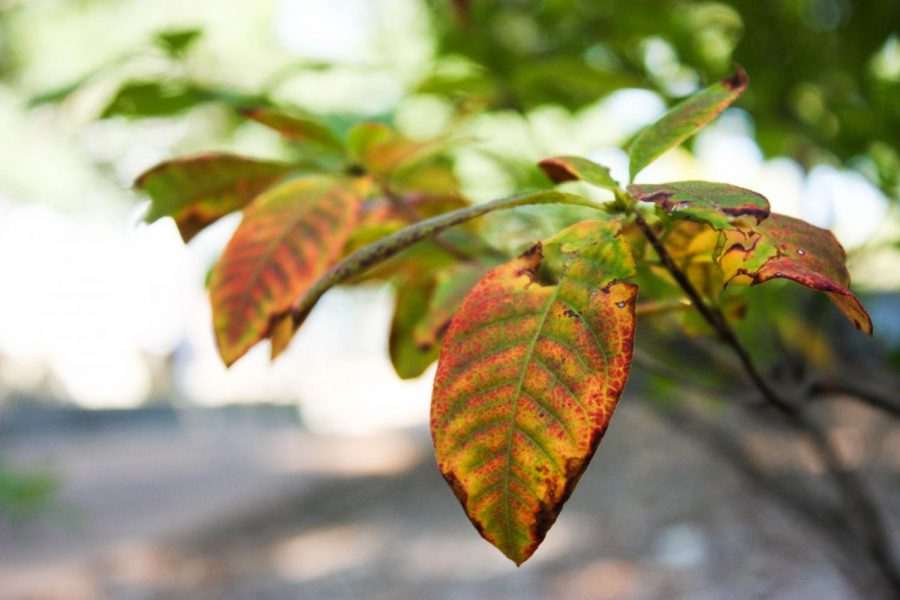Your donation will support the student journalists of Grand Center Arts Academy. Your contribution will allow us to purchase equipment and cover our annual website hosting costs.
A leaf in the Climatron. This is an example of how you can use plants for an artistic composition given that they are stationary. If it could move, I would have never been able to go something like this.
Missouri Botanical Garden features well-composed environments, opportunity
November 28, 2017
Although I do consider animals my preferred subjects, plants are a fairly close second. The good thing about them is that you can move around them and play a lot with angles and perspectives, as they won’t move and you have a lot more freedom to move around then with an animal. This makes them great for stylistic experimentation, and allows you to really consider your composition as you photograph it, as they will not be going away anytime soon. They often display very interesting patterns, colors and textures and given their vast variety of possible colors, a lot of potential for well-contrasted photos. A great place to find such subjects is the Missouri Botanical Garden, a 79 acre park full of a variety of plants.
Additionally, it goes without saying that plants change with the seasons, so depending on the time of year you will have different things to expect. At pretty much any point in time, there will be something in a visually interesting stage of its cycle. In the indoor exhibits, things are much more consistent, but they still can vary, not to mention plants are often replaced. This way, you never run out of photos to take.
The one drawback is that admission isn’t free. If you plan on being a frequent visitor, you may benefit from purchasing a membership, which will give free admission for at least one person, along with other awards that vary depending on the level. If you’re interested in that, you can find details on their website.
For if you live nearby and don’t want to pay, there are plenty of plants on its outside, and the neighborhood it is set in offers some photography opportunities, and it’s right next to the free Tower Grove Park, which’s photo opportunities are a review of their own.
As for the actual parks, there are a lot of things to go over, as it contains a lot of different exhibits. It starts with the visitor center, which does sometimes have special exhibits in it. You then walk out into the park in front of a large fountain that operates seasonally. From that point, you have two ways you could go- right, towards the well-known Climatron, or left, towards the rose garden. The path is essentially a loop, so it doesn’t matter which way you start, but I prefer to go straight to the Climatron.

A photo taken in the wildflower garden. Notice the complementary dominant colors and how the sunlight adds to the feel of the photo.
If you choose to go towards the Climatron like I do, you follow a path that will eventually lead you there. As you would expect, it is bordered with flower beds that are worthy of photography. These plants tend to vary seasonally. Then, you arrive to the Temperate House, which is attached to the Climatron. On the outside of it, there’s a large wildflower garden, and it is absolutely beautiful. In my opinion, it offers opportunities even better than the Climatron, as it offers natural light. One day I went when it was sunny, and I was quite happy with the way that sunlight affected my results. I think it helps with the feeling of the photos. Definitely don’t skip this part.
Once you get to the Climatron, in front of the door there are some ponds filled with various lily pad species, some of them very large and impressive. There are also some colorful, abstract glass sculptures made by glass sculptor Dale Chihuly leftover from 2007 when they displayed a surplus of his work in a park-wide exhibit. Several other Chihuly sculptures are scattered throughout the park, including one in the Visitor Center. I think they are gorgeous and can make for awesome photos with the way that they reflect on the water they float in. Keep in mind that they are brought inside for the winter to keep them from breaking. Definitely pay attention to the reflections in these ponds and think about how you can use them in your photo.
The actual Climatron is a large dome with a rainforest habitat, displaying an ecosystem of jungle-dwelling plants of all sizes, and even a few animals. It is complete with waterfalls and small pools. It is extremely impressive and offers a great deal of photo opportunities. I will warn you that the light is pretty low in some spots, so I’d recommend using a low-aperture lens. Tripods and monopods are prohibited in buildings, so getting stability will be difficult. Fortunately though, there’s nothing too intense, and even if you can’t take photos in the darker spots there will be areas where you will to make up for it.

A hanging plant in the Climatron. Notice how the circular shapes scattered on the plant and how they add appeal to the photo. Things like that are one of the reasons why plants are such great subjects.
At the end of the Climatron, there are some geckos. Given that they are small, and are situated a couple feet away from the path, you will need a decent zoom to photograph one. Additionally, mice are attracted to that spot, likely because of the gecko food, and and you can take advantage of that too, although it is pretty difficult to photograph the mice because this area is pretty dark and the mice are quick to react to movement. The geckos tend to be pretty stationary, so you have a much better chance with them.
When you leave the Climatron, you enter a children’s play exhibit. When you are here, you have two options. You could go straight outside or to the aforementioned Temperate House. It is similar to the Climatron, but it is less ecosystem based. The aspect is still there, but much less so, as it does seem like things are more organized into sections. It features from a mediterranean climate (which are characterized by their mild winters). Some of the plant collections are important economic plants of mediterranean areas, like figs, grapes, figs and more, an area dedicated to plants from the bible, Madagascar plants, and a bog of carnivorous plants. The architecture is also prominent and is very much a part of the exhibit. For example, there is an fountain area made of colorful porcelain tiles. There’s also a small stream at the entrance with fish. It’s not quite as grand as the Climatron, but it definitely has its own charm and features some visually interesting plants, making it worth a visit.

This succulent plant in the temperate house is one of the interesting and unusual plants held in this area.
Considering you’re still on the same path, you’ll be led past the large Children’s Garden to the lake in the back. On the way there there will be a path to the one of the two rose gardens and the chinese garden. The path to the former runs through various garden arrangements. The exhibit itself is exactly what it says. It’s an area made up of rows of more than 150 rose varieties and not much else. This can be an advantage if you only want roses in the background rather than one that could be distracting. It is definitely worth the walk and the time when roses are in bloom.
The Chinese Garden is a small but well worthwhile section. It features charming oriental architecture, a mosaic path and a small pond. Many of the plants it features originate from China. This section is more about the overall design than the individual plants, but they all come together to create something serene and beautiful. Because of this, you should focus more on taking environmental scenery shots rather than close ups.
Past this, you’ll pass various gardens that you can explore further with offshoot paths. They supply plenty of opportunity. Close to where the path turns with the lake, there’s a maze of paths lined the boxwoods shrubs, the area’s namesake, enclosing flowers that contrast their green colors. As visually interesting as it is, I haven’t had much success with photography here. That has something to do with the fact that far-out shots aren’t exactly my strong point. If you are good with that kind of thing, this is probably something you’d like to try, but if not, a close-up photo will fail to capture the beauty of the exhibit.
If you take the previously mentioned turn around the lake, there’s an area called the Carver Garden. It celebrates the life of George Washington Carver, a botanist born in Missouri enslaved who would go on despite that to be a great influence in agriculture. To be honest, I haven’t spent much time with photography here. For whatever reason, I’m never able to focus much on photography when I’m there- be it a dead camera battery, full memory card or me being there with a friend with little patience for stopping at every garden for 15 minutes to photograph the plants there. Therefore, the advice I can give you is pretty limited. What I do know is that it is a nice tribute to such an important figure in the field of Botany. One recommendation I can give you is in regards to a fountain ring that frames a life-sized bronze sculpture of Carter. I gave this tip for waterfalls in my review for the zoo, but using the support of a tripod (it’s okay because it isn’t in a building) you can set your camera to shutter speed priority and set it to a long duration. This will give the water a flowing effect. Definitely experiment your shutter speed settings to find what works best. This technique is called long exposure. It could also be applied to the waterfalls in the Climatron, but you will have to find other means of support than a tripod.
Back on the main path, you’ll pass a stream that comes off the lake. It adds to the picturesque nature of that particular spot and is certainly something to keep in mind, as there are many different ways you could use it to compose a great photo.
The entire lake area is beautiful and full of infinite opportunity. On this side, the lake is bordered with smooth, dark gray rocks. Definitely watch for reflections on the water of the trees and shrubs and think of how they could be incorporated into your photo to make it stronger. There’s also a bridge to an island that is only open during their annual Japanese festival. Throughout the year though, you can walk on half of the bridge, which you can use to get more perspectives. The bridge also can add a lot to the photos that its in.

The lake in late winter. Notice how I payed close attention to the reflections in the water when I took the photo.
There’s a koi feeding bridge where visitors can purchase handfuls of fish food pellets for huge amounts of large, colorful koi fish. Because they come out from the surface to catch the food, there’s a photo opportunity here. They often form entertaining “expressions” in their attempts to catch to food and display interesting patterns and colors. It may take a while to get something outstanding, but the opportunity is certainly there.
You are now on the left side of of the park. As you continue walking, you’ll walk past the Japanese Garden , which, similar to the Chinese Garden, has a very calming, serene quality that can be used to create photos of that nature. It displays many forms of traditional Japanese art, most prominently a zen garden along the path. It’s not nearly as colorful as the other areas, but this in no way diminishes the photo value. It actually gives a chance to focus more on tones.
As soon as the path leads you turn away from the lake, you’ll be in the English Woodland Garden, which based on its setup is a good opportunity that can resemble a real woodland. This will give the photos a naturalistic quality. It features dogwoods, azaleas and rhododendrons. Spring is a great time to come because these things will be in bloom.
Close to the woodland garden, there’s also a German Garden that displays native German plants or that are somehow connected to the country in other ways. The setup is similar to the previously described area, it’s a woodland setting consisting of herbs, trees and shrubs. It is meant to look unarranged, contributing to a naturalistic feel. Although it may not stand out quite as well as other parts, it certainly is not to be overlooked by photographers, as it presents many opportunities similar to the English Woodland Garden.
Past that, there’s a section that included the Tower Grove House, a maze, and a tower. Although I am sure it offers a lot of opportunity, this is a section I’ve often found myself skipping to save time, as it veers off the main path.
If you continue down this path, you’ll get to a daylily garden. For some reason, there’s something about these flowers that I find difficult to photograph. That doesn’t make it not worth the effort, as they have interesting shapes and their insides in particular have interesting details with their stamen. They have several different colors, so depending on where you take the photo you’ll be able to show color contrast too.
Not far from there, there’s a similar iris garden. Irises make for interesting subjects because they often have different contrasting colors in a single flower.
If you keep traveling up from there, you’ll arrive the second of the two rose gardens, which is similar in setup. In the same area, there are four pools with statues that can create interesting reflections, definitely something you’ll want to pay attention to.
At this point you’ll be very close to the visitor center, but there’ s still one more thing worth checking out. That is a building close the entrance called the Linnean House, a display greenhouse including sub-tropical plants. Given that it is a house, the backgrounds will not match the subjects well a lot of the time, so I recommend using a low aperture and using the focus to obscure the background, as it will simply be distracting and not add anything to the image’s tone otherwise. This is a tip applicable in many parts of the garden, but now more than ever.

A cactus in the Linnean House. Notice how I obscured the backgound, as it looks very unnatural and unappealing otherwise.
One of the notable plants held in the Linnean House are Camellias, a type of flowering shrub, including endangered varieties. They are in bloom from December to April.
If you have time on your way out, you could stop in the gift shop, because they actually have a decent sized selection of plants for sale in there you can photograph. Keep in mind that it may be a bit difficult given you’re dealing with indoor lighting, but there are actually some interesting plants for sale there.
The Missouri Botanical Garden is a beautiful park with a photography opportunity in every square inch. If you have time and money on your hands, I highly recommend you check it out.

